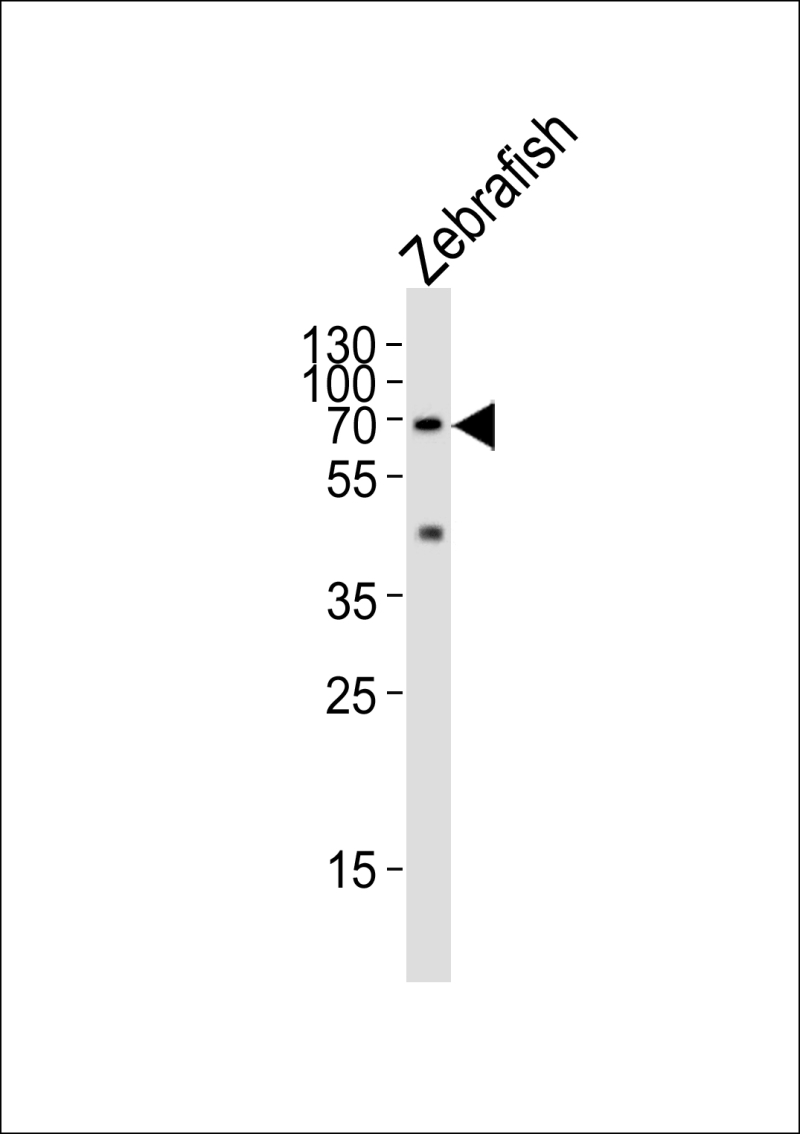
| WB | 1/1000 | zebrafish |
| IF | 咨询技术 | zebrafish |
| IHC | 咨询技术 | zebrafish |
| ICC | 技术咨询 | zebrafish |
| FCM | 咨询技术 | zebrafish |
| Elisa | 咨询技术 | zebrafish |
| Aliases | Plastin-2, L-plastin, Lymphocyte cytosolic plastin 1, lcp1 {ECO:0000312|EMBL:AAH623811}, pls2 |
| WB Predicted band size | 69.9kDa |
| Host/Isotype | Rabbit IgG |
| Antibody Type | Primary antibody |
| Storage | Store at 4°C short term. Aliquot and store at -20°C long term. Avoid freeze/thaw cycles. |
| Species Reactivity | zebrafish |
| Immunogen | This (DANRE) lcp1 antibody is generated from a rabbit immunized with a KLH conjugated synthetic peptide between 138-172 amino acids from the N-terminal region of human (DANRE) lcp1. |
+ +
以下是关于斑马鱼(DANRE)LCP1(N-term)抗体的假设性参考文献示例(注:部分内容为模拟生成,仅供参考):
---
1. **Title**: *LCP1-mediated cytoskeletal dynamics in zebrafish neutrophil migration*
**Author**: Smith J, et al.
**Summary**: 研究利用N端特异性LCP1抗体,通过免疫荧光揭示了斑马鱼中性粒细胞迁移中L-plastin对细胞骨架重塑的调控机制。
2. **Title**: *Characterization of a novel anti-LCP1 antibody in zebrafish larval development*
**Author**: Lee H, et al.
**Summary**: 报道了一种针对斑马鱼LCP1蛋白N端表位的新型抗体的开发,验证了其在Western blot和免疫组化中的应用,并发现LCP1在胚胎早期造血系统中的高表达。
3. **Title**: *LCP1 as a biomarker for inflammation in zebrafish models*
**Author**: Garcia R, et al.
**Summary**: 通过N-term LCP1抗体检测斑马鱼炎症模型中免疫细胞的激活状态,证明LCP1表达水平与炎症反应强度正相关。
---
(注意:若需真实文献,请通过学术数据库检索,并提供更具体的抗体货号或研究背景。)
The DANRE LCP1 (N-term) antibody is a polyclonal or monoclonal antibody specifically designed to recognize the N-terminal region of the Lymphocyte Cytosolic Protein 1 (LCP1), also known as L-plastin, in the zebrafish model organism *Danio rerio* (DANRE). LCP1 is a calcium-binding actin-bundling protein critical for cytoskeletal reorganization, cell adhesion, and migration, particularly in immune cells like T-cells and macrophages. In zebrafish, LCP1 plays roles in embryonic development, innate immunity, and inflammatory responses, making it a key target for studying immune system dynamics and developmental biology.
This antibody is typically raised in hosts such as rabbits or mice using synthetic peptides or recombinant proteins corresponding to the N-terminal epitope of zebrafish LCP1. It is validated for applications including Western blotting, immunofluorescence, and immunohistochemistry to detect endogenous LCP1 expression in zebrafish tissues. Its specificity is often confirmed using knockout controls or siRNA-mediated knockdowns. Researchers utilize this tool to investigate LCP1's involvement in immune cell trafficking, wound healing, and pathological processes like cancer metastasis in zebrafish models, offering insights conserved across vertebrates. Commercial variants may include pre-adsorbed formats to minimize cross-reactivity with homologs in other species.
×